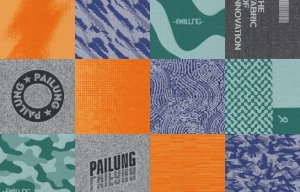
Pailung at TITAS 2023
Paid content
Versatile, comfortable and sustainable.

27th March 2023
Knitting Industry
|
Taiwan
Ideal for fashion and apparel – Pailung’s latest fabric technology, AlterKnit, enables textile designers and manufacturers to produce luxurious fabrics with intricate patterns, knitted into their structure, negating any need for post-production printing or dyeing.
AlterKnit is an upgraded version of inverse plating. It works by knitting alternate yarns into the fabric's structure. The process is performed on circular knitting machines, whereby yarns of different colour or composition can be knitted together within the same row.
The technology yields crisp patterns with sharp borders – a noticeable step up from standard inverse plating. Extremely versatile, it provides unlimited pattern possibilities for designers, capable of capturing gradient designs, argyle, and denim patterns etc. It can capture the intricate details of a sports team emblem, for example, including text and logos. AlterKnit fabric is also reversible, producing 2 inverted versions of the same design (with up to 4 colours) on either side.

In terms of texture, the fabric has a smooth, even surface, making it comfortable to wear, as it fits snugly against the body. In single knit, the technology produces lightweight fabric that feels like second skin and is well-suited to sports apparel or athleisure applications. In double-knit, the fabric is sturdier, but it’s still 50% lighter than 4-color jacquard, making it ideal for contact sports, such as basketball, football, hockey, soccer, and rugby.
When designing for adventure or endurance activities, different types of yarn can be combined to create functional fabrics with enhanced features, such as moisture-wicking, breathability, elasticity etc.

AlterKnit reduces water pollution
Printing and dyeing may be the traditional methods for manufacturing patterned textiles, but consumers and governments are becoming increasingly concerned about the environmental impact of dyes, which can leak out of fabric, and printing adhesives that can disintegrate, polluting waterways. There’s growing demand for patterned textiles that both look and feel great, while championing sustainability.
Unlike traditional printing, the designs seen on AlterKnit fabrics are knitted into the fabric's structure. This prevents the designs, along with any chemicals used during production, from rubbing off or leaking into the surrounding environment.
Through the selection of raw materials, AlterKnit can further prevent chemicals from leaking out. Some methods of manufacturing colourful, patterned fabric involve dyeing completed pieces, however, AlterKnit fabrics use yarn that's dyed before the knitting process. This not only provides greater control over the colour and pattern, but also allows the dye to penetrate deeper into the fibres. It increases colour durability, as the dyes are less likely to fade away due to long-term use, or exposure to sunlight and chemicals – like those used in washing machines.

AlterKnit reduces textile waste
Overall, the long-lasting nature of AlterKnit increases the lifespan of finished garments, preventing them from being quickly discarded, sent to a landfill, or incinerated. Recycled or biodegradable yarns can also be utilized. This can, effectively, help to reduce textile waste and support a Closed-loop fashion industry.
The AlterKnit process can also reduce waste during production. In certain techniques, like Intarsia, yarns of different colours are knitted together, causing strands of loose yarn to run along the back of the fabric. These are known as yarn floats. Other methods include splicing or ‘cut-and-sew’, which involves cutting pieces of fabric in different colours and stitching them together, creating scraps that would be hard to recycle or repurpose.
In the case of AlterKnit, and the inverse plating technique, both front and back of the fabric will display patterns that mirror each other, which means there are no yarn floats to trim away, resulting in less textile waste. Patterns and colours are directly knitted into the fabric structure, so there’s no need to splice together different coloured fabrics. As a result, AlterKnit not only reduces waste, but also the time, energy, and labour associated with trimming yarn floats or ‘cut-and-sew’.
Pailung Machinery Mill Co., Ltd.
Pailung is a knitting machinery innovator, based in Taiwan. Through persistent research and development, Pailung’s fabric technology is continuously reiterated and improved upon, moving the textile industry forward at a sustainable rate.
In June 2023, Pailung will exhibit AlterKnit at ITMA in Milan, alongside its portfolio of advanced, circular knitting machines, fabric technologies, and system innovations, including the MES and fabric defect detection systems.
Heading to ITMA 2023?
Pailung will be presenting a seminar on its AlterKnit fabric technology. Scan the QR Code below or follow this link to register and visit Pailung's booth in Hall 2, C101.


Business intelligence for the fibre, textiles and apparel industries: technologies, innovations, markets, investments, trade policy, sourcing, strategy...
Find out more